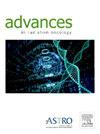Esophageal Circumferential Dose-Length Histogram Parameters to Predict Dysphagia in Patients Receiving Thoracic Radiation Therapy: A Single-Institution Experience
IF 2.7
Q3 ONCOLOGY
引用次数: 0
Abstract
Purpose
Chemoradiation for locally advanced non-small cell lung cancer can cause severe esophagitis. Techniques to spare the contralateral esophagus may mitigate toxicity, but traditional dose-volume histograms (DVH) do not capture the degree of circumferential irradiation. We evaluated dose-length histogram (DLH) parameters as predictors of dysphagia compared with DVH metrics.
Methods
We retrospectively reviewed patients treated with definitive thoracic radiation therapy from 2019 to 2023. Descriptive statistics described the cohort. Clinician-reported (National Cancer Institute Common Terminology Criteria for Adverse Events [CTCAE] v.4) and patient-reported outcomes (PRO)-CTCAE v.1 dysphagia within 120 days of treatment start were collected prospectively. The McNemar test compared dichotomized scores. The length of esophageal full-circumferential (LFdose) and partial-circumferential irradiation (LPdose) was defined as the length of the esophagus with ≥90% and ≥50% circumference exposure to threshold radiation doses, respectively. Spearman correlation examined relationships between LFdose, LPdose, and volumetric (Vdose) parameters. Associations between LFdose, LPdose, and Vdose, and grade ≥2 dysphagia were evaluated using univariate logistic regression. Likelihood ratio tests assessed model fit.
Results
Of 107 patients, 86.9% (93) had non-small cell lung cancer, all received ≥60 Gy (median, 63 Gy; range, 60-70 Gy), and 94.4% (101) received concurrent chemotherapy. Patients and physicians reported rates of grade ≥2 dysphagia differently: 17 (15.9%) and 6 (5.6%), respectively (P = .0015). Each 0.5 cm increase in the length of partial-circumference esophagus receiving ≥55 Gy (LP55) and 60 Gy (LP60) resulted in increased odds of PRO-CTCAE dysphagia by 8% and 9%, respectively. Each 0.5 cm increase in full-circumference esophagus receiving ≥60 Gy (LF60) resulted in 11% increased odds of PRO-CTCAE dysphagia. Esophageal DLH parameters, LP55 and LP60, correlated with the esophageal V60 volumetric parameter strongly (ρ = 0.751 and 0.729, respectively). No DVH or DLH parameter predicted grade ≥2 CTCAE dysphagia.
Conclusion
Esophageal DLH metrics assessing partial- or full-circumferential esophageal irradiation, specifically LP55, LP60, and LF60, are associated with patient-reported dysphagia and complement traditional DVH parameters.
食道周向剂量-长度直方图参数预测接受胸部放射治疗患者的吞咽困难:一项单一机构的经验
目的局部晚期非小细胞肺癌放血治疗可引起严重的食管炎。避开对侧食道的技术可能减轻毒性,但传统的剂量-体积直方图(DVH)不能捕捉到环周照射的程度。我们评估了剂量-长度直方图(DLH)参数与DVH指标相比作为吞咽困难的预测指标。方法回顾性分析2019年至2023年接受胸部放射治疗的患者。描述性统计描述了队列。前瞻性收集临床报告(美国国家癌症研究所不良事件通用术语标准[CTCAE] v.4)和患者报告结果(PRO)-CTCAE v.1治疗开始120天内的吞咽困难。McNemar测试比较的是二分类分数。食管全周照射长度(LFdose)和部分周照射长度(LPdose)分别定义为阈值辐射剂量周长≥90%和≥50%时的食管长度。Spearman相关性检验了低剂量、低剂量和体积(Vdose)参数之间的关系。使用单变量logistic回归评估LFdose、LPdose和Vdose与≥2级吞咽困难之间的关系。似然比检验评估模型拟合。结果107例患者中,86.9%(93例)为非小细胞肺癌,均接受≥60 Gy(中位数:63 Gy;范围,60-70 Gy), 94.4%(101)接受了同期化疗。患者和医生报告的≥2级吞咽困难发生率不同:分别为17(15.9%)和6 (5.6%)(P = 0.0015)。≥55 Gy (LP55)和60 Gy (LP60)的部分围度食管长度每增加0.5 cm, PRO-CTCAE吞咽困难的发生率分别增加8%和9%。接受≥60 Gy (LF60)的全周长食管每增加0.5 cm, PRO-CTCAE吞咽困难的几率增加11%。食管DLH参数LP55和LP60与食管V60体积参数相关性较强(ρ分别为0.751和0.729)。没有DVH或DLH参数预测≥2级CTCAE吞咽困难。结论评估部分或全周食管辐照的食管DLH指标,特别是LP55、LP60和LF60,与患者报告的吞咽困难有关,并补充了传统的DVH参数。
本文章由计算机程序翻译,如有差异,请以英文原文为准。
求助全文
约1分钟内获得全文
求助全文
来源期刊

Advances in Radiation Oncology
Medicine-Radiology, Nuclear Medicine and Imaging
CiteScore
4.60
自引率
4.30%
发文量
208
审稿时长
98 days
期刊介绍:
The purpose of Advances is to provide information for clinicians who use radiation therapy by publishing: Clinical trial reports and reanalyses. Basic science original reports. Manuscripts examining health services research, comparative and cost effectiveness research, and systematic reviews. Case reports documenting unusual problems and solutions. High quality multi and single institutional series, as well as other novel retrospective hypothesis generating series. Timely critical reviews on important topics in radiation oncology, such as side effects. Articles reporting the natural history of disease and patterns of failure, particularly as they relate to treatment volume delineation. Articles on safety and quality in radiation therapy. Essays on clinical experience. Articles on practice transformation in radiation oncology, in particular: Aspects of health policy that may impact the future practice of radiation oncology. How information technology, such as data analytics and systems innovations, will change radiation oncology practice. Articles on imaging as they relate to radiation therapy treatment.
 求助内容:
求助内容: 应助结果提醒方式:
应助结果提醒方式:


